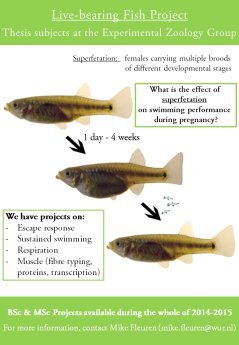
Thesis subject
Swimming performance in pregnant livebearing fish
Are you interested in how animals move? Do you want to know more about the effects of pregnancy on locomotion and how you can reduce those? Or do you want to see fish being born? Then this thesis subject might be what you’re looking for!
Everybody knows that humans and other mammals give birth to live young but it’s less known that viviparity (live-bearing) evolved in all major vertebrate clades except birds. In my research project, I study the effects of live-bearing on swimming performance in Poeciliidae fish. In this family, known for aquarium fish like the guppy and swordtails, almost all species are viviparous, but they have different strategies regarding nutrient provisioning to the offspring and the amount of multiple broods of different developmental stages being reared at the same time. The latter phenomenon is called superfetation and is the specific subject of my research. Superfetation might be an important factor that helps the evolution of live-bearing in this family.

In the coming year, thesis subjects are available on oxygen uptake and respiration in pregnant fish, the effects of superfetation on escape performance, and whether or not pregnancy influences the female’s endurance and swimming kinematics. For these subjects, we use state-of-the-art (3D) high speed video analysis. Furthermore, we want to know if pregnancy changes the physiology of the muscles – can it be that pregnancy has a bigger effect than just a change in shape?
These subjects are available during the whole of 2014-2015. They are best suited for MSc students, but BSc thesis students are welcome to apply as well. More information on the (broader) project can be found on www.bartpollux.nl.
Apply by sending an e-mail to me using the contact form. I would like to welcome you at the Experimental Zoology Group!
Subtopics:
Differences in shape, volume and drag in different species of live-bearing fish
BSc-thesis
During their pregnancies, live-bearing fish quickly increase in size in the abdominal region. They can increase about 10% in total volume over the span of just one week, but the volume of the abdominal region can change as much as 25%. This change in volume will have big effects on their swimming performance, for a large part caused by the drag increase that comes with the increase in volume. During this project, you will analyse the changes in body shape in live-bearing fish and calculate the subsequent expected drag. Comparisons will be made within species (multiple time points in the same individual, comparison between pregnant and virgin females) and between species with different life-histories.
| Examiner: | prof.dr. Johan van Leeuwen |
| Group: | Experimental Zoology |
| Supervisors: | Mike Fleuren |
| Bart Pollux | |
| Contact: | Mike Fleuren (via contact form) |
| Credits: | depends |
| For: | BSc and MSc Animal Sciences and Biology |
| Requirements: | depends |